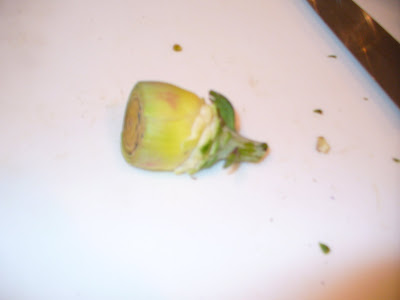So we here have a four-day weekend that happens to include The Man's birthday. In anticipation of this big event, we went to the Fresh Fields and spent about $952 on groceries, and Bunny brought home a few things she ordinarily does not bother with, to wit:

Fresh Baby Artichokes. Canned artichokes are wonderful. They are a staple here
Chez Nous. However, fresh artichokes are a rare pleasure and the
Fresh Fields was offering a package of 12 for $3.99. So they came home.
Prepare baby artichokes pretty much the same way as grown-up artichokes, minus a little extra work. Step 1: Artichokes start to oxidize (go brown and ugly) quickly unless the process is counteracted by an acid, traditionally a bowl of ice water with the juice of a lemon. So first, get yourself a bowl of water and put the juice of a lemon in it.
Now let's get down to business. Are you ready? There he is. On your cutting board and you have your good big knife and a good little knife or vegetable peeler, and your bowl of weak acid solution. Here we go:
Step 2.
Whack off the grody end of the stem and about the top third. The "experts" all tell you to take of the stem. I like the stem, so I leave it on.
Step 3: Pick that baby up and look at the cut end. You'll see that the outer leaves are green and the inner leaves are more yellow. Stick your thumb in there are start ripping off the green leaves en masse, but leave the yellow ones behind:
Or you can do it the "expert" slowpoke deliberate way and peel off the green leaves one at a time until they're gone. The point, though, is that preparing artichokes doesn't have to be a big honking deal and my way is faster. You'll end up with something like this:
You'll have some tiny leaves near the stem, the kind of woody green outer layer of the stem itself, and the very bottom ends of the outer leaves where they attach to the heart. Your goal is to separate the woody, stringy, yucky part from the tender edible part.
Step 4:
Using either your paring knife or your vegetable peeler, just peel off the outer layer of the stem, starting from the cut end and working towards the leaves.
Go all the way around once, and you end up with this:
Plunk it in the lemon water. You are done.
Ta Da!
I don't have lemon water today. I have a half-empty pitcher of lime water, so I'm using that.
If you are preparing baby artichokes, you are done. If you are preparing grown-up artichokes (which I'm not, so I don't have pictures), you have to remove the "choke." In the very center of the leaves at the very heart of the thing is a layer of slightly prickly teeny tiny purplish leaves that surround a fuzzy crown of fibrous stuff that is as delicious to eat as dog hair or corn silk. Stick your thumb into the center of it all to separate the leaves, reach in there with a teaspoon, and scoop out the purple stuff and the hairy stuff and throw it away or compost it. This is easier to do if you cut the artichokes in halves or quarters the long way first, but that doesn't work if you need to leave the damn thing whole. Anyway, scoop out the choke and dunk the remaining good part into you lemon water.
Ta Da!
You are done.
Now you need to cook the damn things. Here is my way to do the babies.
Heat up a decent sized glom of olive oil and the juice of a lemon.
When the oil sizzles around the lemon juice, put in the babies.
Stir them around thoroughly for a good minute or two to ensure that they are nicely coated with the oil and the anti-brown making lemon juice because you don't want them getting brown and nasty. When the pan is nice and hot and everything is well coated, pour in about a quarter-cup or so of water. Heat until the water boils, stir a few times, then cover and turn the heat down to low or medium-low.
Let them steam for about 5 -8 minutes, checking them every so often for two reasons: 1. Is the water still making steam? If not, your pan is too cold. Turn the heat up. OR, you burned off all your water and you need to add more if the babies aren't done yet. 2. Are they done yet? Poke them through the center with a good knife to see how tender they are.
When they seem appropriately tender (use your own judgment. Pull one out and taste it if you don't trust yourself), take the lid off and turn the heat back up to boil off any remaining water. When the water is gone, the babies will saute a little in the dregs of the oil. I like to let them brown just a wee bit because they look prettier. When they look about right, pour them out into a bowl and dress with salt, pepper, olive oil (if you want) and acid of your choice (lemon or wine vinegar).
From here, you can marinate them for a salad, or slice them for a pasta sauce, or whatever. The whole shebang, from taking them out of the fridge until dumping them out of the pan, takes about 20 minutes. I'm not doing this on a work night, but when they're on sale and it's the weekend and I happen to feel like it, well, there you go.












